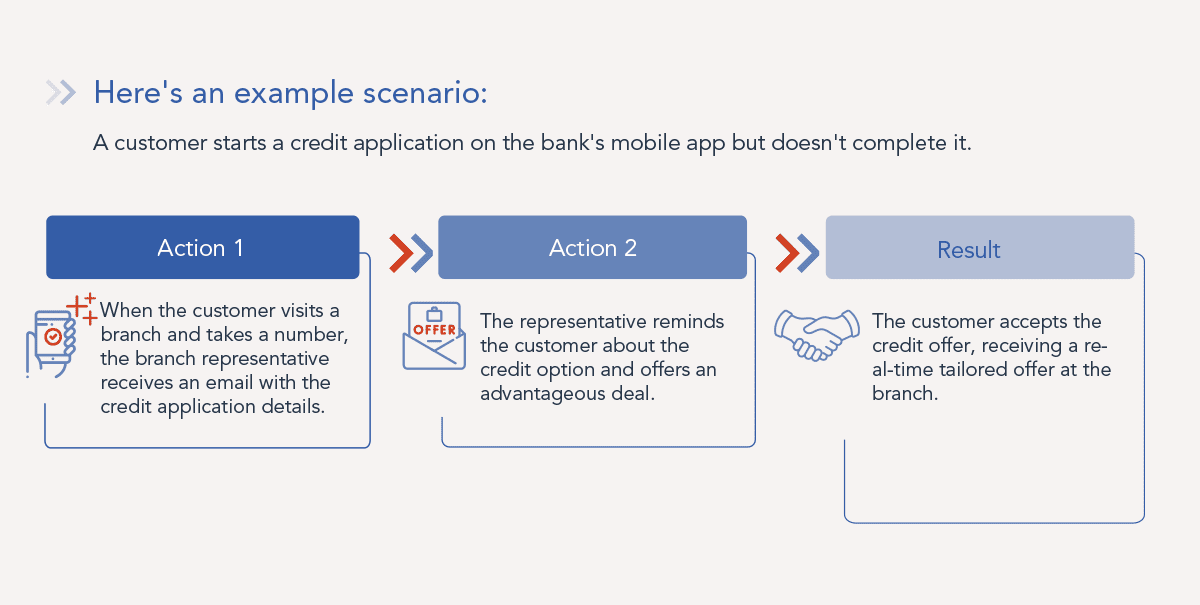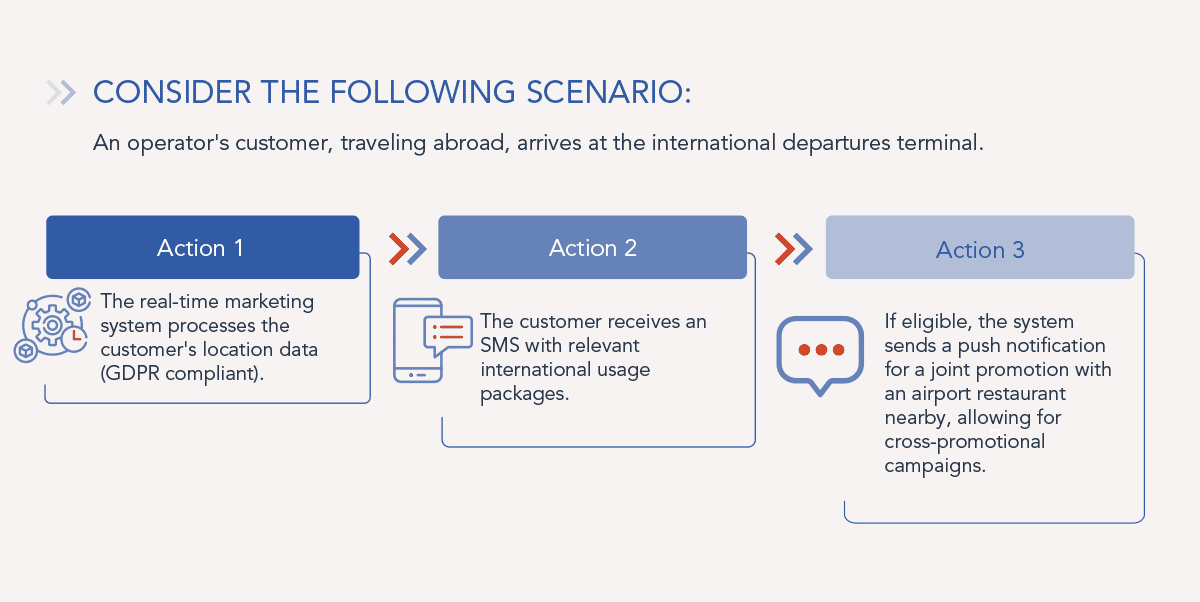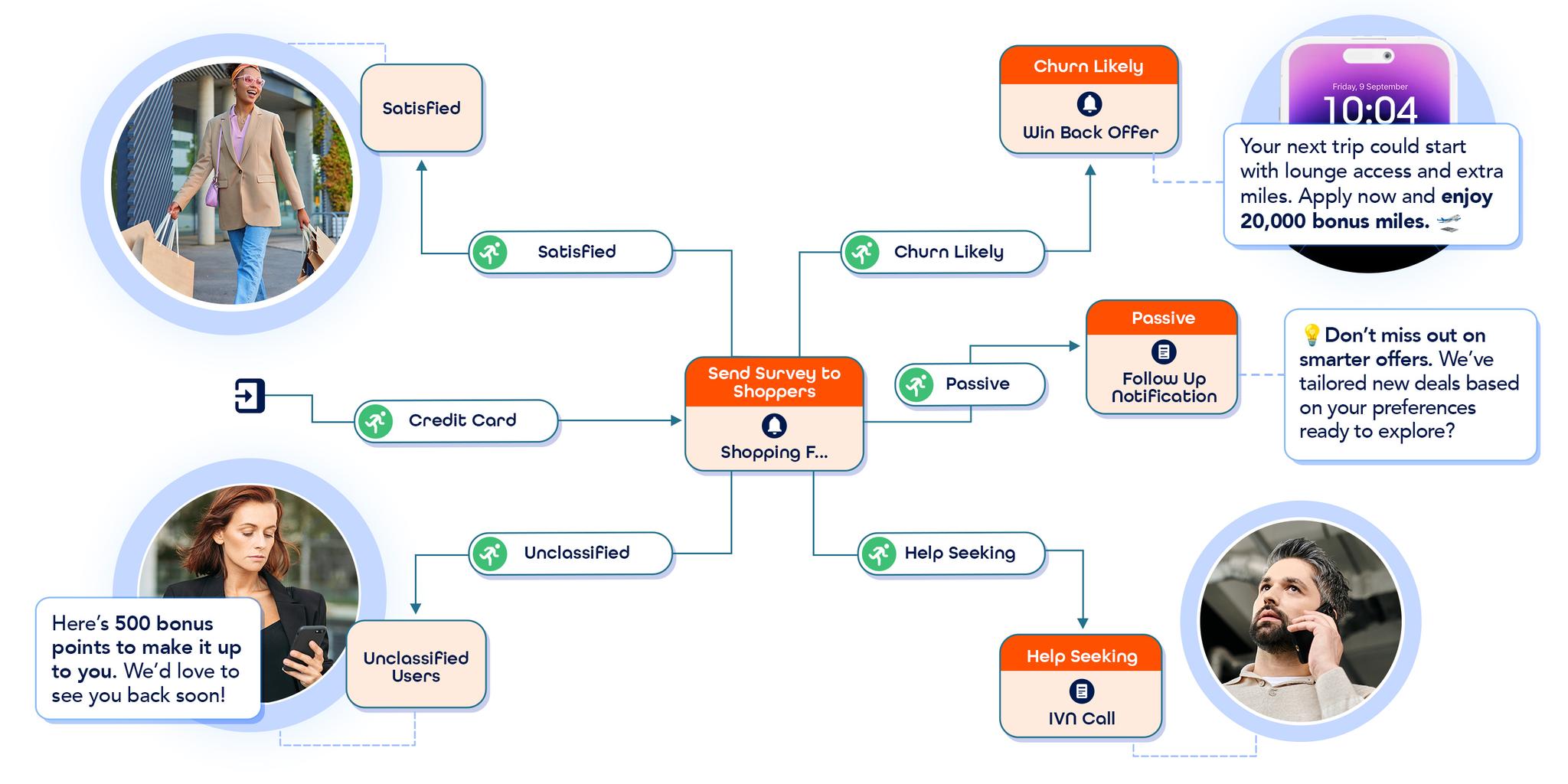Table of Contents
- The New Era of Customer Expectations
- The Current State of Real-Time Marketing
-
Applications of Real-Time Marketing Across Industries
- Real-Time Marketing in Financial Services
- Real-Time Marketing in Telecommunications
- Real-Time Marketing in Retail
- Let’s Partner Up to Help You Move at the Speed of Your Customers
In today’s fast-paced marketing landscape, staying ahead of the competition requires businesses to grasp the opportunities arising from evolving consumer expectations and technologies.
Marketing teams need to discover more data-driven methods of understanding their customers and creating marketing campaigns that drive contextual customer engagement.

This is where real-time marketing (RTM) comes into play. RTM is a highly significant marketing strategy that empowers marketers to instantly connect with their customers through relevant messaging, channels, and offers.
A real-time marketing strategy can increase customer retention, boost conversion rates, and improve brand perception for both B2C and B2B organizations.
In this blog post, we will delve deeper into the concept of real-time marketing and provide insightful examples to assist you in understanding what it exactly entails.
The New Era of Customer Expectations
In today’s fully digitized world, we have become accustomed to having easy access to information, products, and services.
As a result, customer expectations have transformed, reshaping the concept of customer experience. Customers now anticipate a higher degree of personalization and relevance. 72% of them only engage with personalized messages and offers.
They desire businesses that truly understand their needs, preferences, and behaviors, and can promptly provide tailored solutions that align with their specific objectives.
A staggering 81% of businesses recognize that customer experience plays a pivotal role in fostering loyalty, driving revenue growth, and achieving cost savings. Real-time marketing serves as a hidden superpower for businesses, enabling them to deliver exceptional experiences and make the most out of their customer relationships.
Therefore, it is crucial to establish a structured and systematic approach to real-time marketing across all communication channels.
The Current State of Real-Time Marketing
RTM is a data-driven and always-on approach to marketing. It involves creating and delivering hyper-personalized marketing campaigns that respond to current events, trends, customer behavior, or feedback in real-time.
The traditional way of implementing this real-time approach could be interpreted as responding to the target audience through social media during events or occasions. However, that was long before the emergence of big data, Artificial Intelligence (AI), and marketing technologies.
Thanks to advancements in these areas, marketers today can take a comprehensive look at the customer journey, analyze available customer data, and utilize real-time interaction management to provide contextual engagement.
Characteristics of Real-Time Marketing:
Data-driven: Leverages data and analytics to gain insights into the customer journey, segment the audience, seize opportunities, and gauge outcomes.
Agile: Demands a dynamic and responsive strategy that empowers marketers to swiftly and efficiently adapt to evolving circumstances and customer demands.
Creative: Entails crafting unique, captivating, and pertinent content that distinguishes itself and deeply connects with the target audience.
Collaborative: Involves fostering collaboration among various teams, including social media, content marketing, design, web development, sales, and customer service, to ensure a synchronized and cohesive content delivery.
Research shows that only 7% of marketers can effectively implement a data-driven approach to real-time marketing. This is because achieving success in RTM requires a combination of skills, tools, and processes. Marketing teams must utilize various sources of information such as CRM tools, marketing technologies, and website analytics.
By gathering up-to-date data from these sources, they can reap the benefits of real-time marketing and create customer-centric journeys.
Applications of Real-Time Marketing Across Industries
RTM offers great flexibility and can be applied to various industries, allowing businesses to customize it according to their specific goals and needs. Let’s explore some examples to understand how it can be utilized in different ways.
Real-Time Marketing in Financial Services
In the financial services industry, customers now expect banks to serve as reliable and accessible financial advisors around the clock. These organizations often possess a wealth of customer data, which can be leveraged to achieve personalized and contextually relevant customer engagement through real-time marketing.
Here’s an example scenario:
A customer starts a credit application on the bank’s mobile app but doesn’t complete it.
When the customer visits a branch and takes a number, the branch representative receives an email with the credit application details.
The representative reminds the customer about the credit option and offers an advantageous deal.
The customer accepts the credit offer, receiving a real-time tailored offer at the branch.

Real-Time Marketing in Telecommunications
Telecommunication companies face various challenges such as profitability and increasing their Average Revenue Per User (ARPU) due to factors like market saturation, the substitution of traditional services, and price wars.
Consider the following scenario:
An operator’s customer, traveling abroad, arrives at the international departures terminal.
The real-time marketing system processes the customer’s location data (GDPR compliant).
The customer receives an SMS with relevant international usage packages.
If eligible, the system sends a push notification for a joint promotion with an airport restaurant nearby, allowing for cross-promotional campaigns.

Real-Time Marketing in Retail
In the retail industry, customers expect a seamless integration between online and offline shopping experiences.
Consider this example:
A customer has many items in their online shopping cart but hasn’t proceeded to checkout yet.
The system sends them a reminder email, accompanied by a limited-time offer of free shipping.
The customer decides to complete their purchase before the offer expires.
The system then follows up with a confirmation email, expressing gratitude and including a coupon for their next order.
This gesture leaves the customer feeling satisfied and rewarded by the retailer.
Let’s Partner Up to Help You Move at the Speed of Your Customers
As a leading Martech company specializing in customer journey orchestration with intelligent capabilities, we empower our customers to elevate their marketing strategies to new heights.
Evam’s event processing engine, Evam Actions, can be your partner in leveraging real-time marketing activities effectively, seizing the right business moments, and taking immediate action.
Would you like to learn more about how we can assist you? Please feel free to reach out to us anytime!
Frequently Asked Questions (FAQ)
1. What is real-time marketing (RTM) and why is it important for modern businesses?
Real-time marketing refers to a strategy that enables businesses to engage with their customers instantly using relevant messaging, offers, and channels based on real-time data and events. It’s especially critical in today’s marketing landscape where customer expectations have evolved toward personalization and immediacy. By leveraging RTM, businesses can improve customer retention, boost conversion rates, and strengthen brand perception. It allows marketing teams to respond dynamically to customer behaviors and deliver hyper-personalized experiences, aligning perfectly with the need for contextual engagement in both B2C and B2B environments.
2. How have customer expectations evolved in the digital age, and what role does RTM play in meeting them?
In our fully digital world, customers expect seamless access to services, immediate responses, and experiences tailored to their individual needs and preferences. Studies show that 72% of consumers only interact with personalized content, while 81% of businesses recognize customer experience as a major driver of loyalty and revenue. Real-time marketing plays a crucial role in fulfilling these expectations by using real-time insights to tailor communications and offers, thereby elevating the customer experience and creating stronger, more personalized connections.
3. What are the core characteristics of effective real-time marketing?
Effective RTM strategies are data-driven, agile, creative, and collaborative. A data-driven approach involves capturing and analyzing customer data in real time to generate insights that guide decision-making. Agility refers to the ability to quickly adapt to changing circumstances and customer behavior. Creativity ensures that the marketing content remains engaging and relevant, while collaboration across departments—from content and social media to sales and customer support—ensures a cohesive delivery of personalized messages. Together, these traits help brands deliver contextual, on-the-spot experiences that resonate with their audience.
4. Why do many marketing teams struggle to implement data-driven real-time marketing?
Despite the growing importance of RTM, only a small percentage of marketers (just 7%) have successfully implemented a truly data-driven approach. This gap exists because RTM demands a sophisticated combination of the right tools, processes, and skill sets. Marketers must gather and interpret insights from diverse systems like CRM platforms, marketing automation tools, and website analytics, which can be complex and resource-intensive. Without a coordinated infrastructure and agile workflow, it becomes challenging to act on real-time data and create seamless customer experiences.
5. How can real-time marketing be applied in the financial services sector?
In financial services, customers expect their banks to act as accessible financial advisors who offer timely, relevant recommendations. An example of RTM in this industry involves a scenario where a customer begins a credit application via a mobile app but doesn’t complete it. Later, when they visit a physical branch, the representative is notified of the incomplete application and offers a tailored promotion. This type of contextual, real-time response makes the customer feel recognized and supported, ultimately enhancing satisfaction and increasing conversion.
6. What are some real-time marketing use cases for the telecommunications industry?
Telecommunication companies operate in a competitive landscape where maintaining ARPU and reducing churn are ongoing challenges. A practical example of RTM for telcos includes identifying a customer’s location at an airport’s international terminal (in compliance with data privacy laws) and sending a relevant roaming package offer via SMS. The system might also push a joint promotion with an airport partner brand. These real-time, location-aware offers help telcos increase service usage, improve customer engagement, and create new revenue streams through timely and contextual interactions.
7. How is real-time marketing used in the retail sector to enhance customer experience?
Retailers can use RTM to bridge online and offline experiences and reduce cart abandonment. For example, when a customer leaves items in their online shopping cart, the system can send a reminder email with a limited-time free shipping offer. If the customer completes the purchase, a follow-up email can thank them and offer a discount on their next order. These timely, relevant interactions demonstrate attentiveness, improve customer satisfaction, and encourage repeat purchases.
8. How does Evam help businesses implement and scale real-time marketing strategies?
Evam provides an advanced Martech ecosystem that includes Evam Actions, a powerful event processing engine designed to support real-time customer engagement. By leveraging Evam’s technology, businesses can capture relevant business moments, make decisions instantly, and take immediate action across various touchpoints. This capability allows marketing teams to orchestrate real-time campaigns, automate contextual offers, and deliver seamless customer journeys that align with today’s evolving expectations. Evam partners with organizations to build intelligent marketing strategies that move at the speed of the customer.








